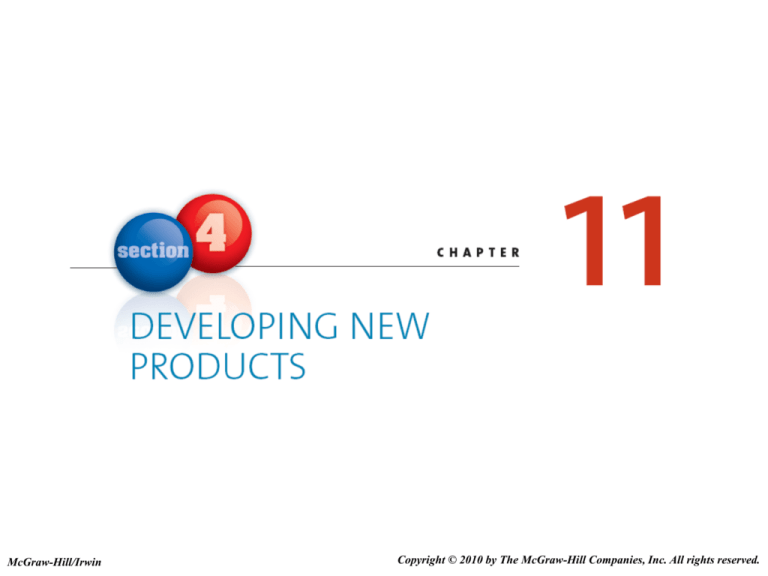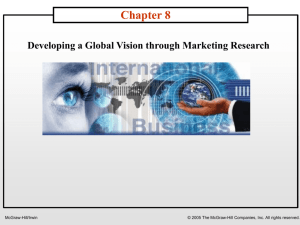
McGraw-Hill/Irwin
Copyright © 2010 by The McGraw-Hill Companies, Inc. All rights reserved.
Learning Objectives
LEARNING OBJECTIVES
How can firms create value through innovation?
What is the diffusion of innovation theory, and
how can managers use it to make product line
decisions?
How do firms create new products and services?
What is a product life cycle, and how can the
concept be applied to product line decisions?
© McGraw-Hill Companies, Inc., McGraw-Hill/Irwin
11-2
Inventables
Build a living showcase of
what’s possible to deliver
inspiration and innovation
to the dreamers of the
world.
Inventables Website
© McGraw-Hill Companies, Inc., McGraw-Hill/Irwin
11-3
Innovation and Value
Satisfy the
changing
needs of
consumers
Benefits
of new
products
Diversify
firm’s risk
© McGraw-Hill Companies, Inc., McGraw-Hill/Irwin
Add value
to the firm
11-4
New Product Introductions
Pioneers radically
change competition
and consumer
preferences.
© McGraw-Hill Companies, Inc., McGraw-Hill/Irwin
11-5
Diffusion of Innovation
© McGraw-Hill Companies, Inc., McGraw-Hill/Irwin
11-6
Recycled Organic Clothes
© McGraw-Hill Companies, Inc., McGraw-Hill/Irwin
11-7
Using the Diffusion of
Innovation Theory
Observability
Compatibility
Trialability
Factors
Affecting
Product
Diffusion
© McGraw-Hill Companies, Inc., McGraw-Hill/Irwin
Relative
Advantage
11-8
The __________ focuses on the rate at which consumers
are likely to adopt a new product or service.
A.
geographic boundary of innovation doctrine
B.
laggards to innovators movement
C.
psychological innovators syndrome
D.
diffusion of innovation theory
E.
all of the above.
© McGraw-Hill Companies, Inc., McGraw-Hill/Irwin
11-9
Check Yourself
1.
What are the five groups depicted in the
diffusion of innovation curve?
2.
What factors enhance the diffusion of a
good or service?
© McGraw-Hill Companies, Inc., McGraw-Hill/Irwin
11-10
How Firms Develop New Products
© McGraw-Hill Companies, Inc., McGraw-Hill/Irwin
11-11
Idea Generation
© McGraw-Hill Companies, Inc., McGraw-Hill/Irwin
11-12
Internal R&D
High product
development costs
Often the source of
technological products
Often the source of
breakthrough products
Crystal Pepsi Commercial
© McGraw-Hill Companies, Inc., McGraw-Hill/Irwin
11-13
R&D Consortia
Lower costs and risks;
firms join together
Form research
consortiums
Benefits spread to all
firms
Example, pharmaceutical
industry research
© McGraw-Hill Companies, Inc., McGraw-Hill/Irwin
11-14
___________ often include university laboratories,
government agencies, competing firms in an industry,
and non-profit organizations.
A.
Research departments
B.
Licensing agents
C.
Customer brainstorming groups
D.
Early adopter organizations
E.
R&D consortia
© McGraw-Hill Companies, Inc., McGraw-Hill/Irwin
11-15
Licensing
Firms purchase the rights to technology or ideas
from other research-intensive firms
University research centers also often provide
such licenses
© McGraw-Hill Companies, Inc., McGraw-Hill/Irwin
11-16
Brainstorming
Groups work together to generate ideas
No idea can be immediately dismissed
IDEO Website
© McGraw-Hill Companies, Inc., McGraw-Hill/Irwin
11-17
Competitors’ Products
Reverse engineering
“Me Too” or copycat
products
© McGraw-Hill Companies, Inc., McGraw-Hill/Irwin
© 2007 McGraw-Hill Companies, Inc., McGraw-Hill/Irwin
11-18
Valerie is involved in ___________________, taking apart a competitor’s
product, analyzing it, and trying to create an improved product that does not
infringe on the competitor’s patents.
A.
spinning
B.
reverse engineering
C.
selective dissection
D.
redistribution
E.
creative destruction
© McGraw-Hill Companies, Inc., McGraw-Hill/Irwin
11-19
Customer Input
As much as 85% of new
business to business
products come from
customers
Lead users modify
existing products
according to their own
specific needs
© McGraw-Hill Companies, Inc., McGraw-Hill/Irwin
© 2007 McGraw-Hill Companies, Inc., McGraw-Hill/Irwin
11-20
Concept Testing
Concept is a brief
written description of
the product
Customers reactions
determine whether or
not it goes forward
Triggers the marketing
research process
© McGraw-Hill Companies, Inc., McGraw-Hill/Irwin
© 2007 McGraw-Hill Companies, Inc., McGraw-Hill/Irwin
11-21
Steve Wynn
© McGraw-Hill Companies, Inc., McGraw-Hill/Irwin
11-22
Product Development
© McGraw-Hill Companies, Inc., McGraw-Hill/Irwin
© 2007 McGraw-Hill Companies, Inc., McGraw-Hill/Irwin
11-23
Market Testing
Premarket
tests
Test
marketing
Customers
exposed
Mini product
launch
Customers
surveyed
More expensive
than premarket
tests
Firm makes
decision
Market demand
is estimated
Dodge Commercial
© McGraw-Hill Companies, Inc., McGraw-Hill/Irwin
© 2007 McGraw-Hill Companies, Inc., McGraw-Hill/Irwin
11-24
Market Testing
How do firms know what market tests need to
be performed to ensure a successful product?
© McGraw-Hill Companies, Inc., McGraw-Hill/Irwin
11-25
Product Launch
Kellogg’s
Drink’n Crunch
Portable
Cereals
•An inner cup contains the cereal
and the outer cup contains the
milk
Minute Maid
Premium
Heart Wise
Orange Juice
•Each 8 oz. serving of the juice
contains 1 gram of plan sterols
that can reduce cholesterol
levels
Aquafresh
Floss ‘N’ Cap
Fluoride
Toothpaste
•The cap of the toothpaste
contains floss
© McGraw-Hill Companies, Inc., McGraw-Hill/Irwin
© 2007 McGraw-Hill Companies, Inc., McGraw-Hill/Irwin
11-26
New Product Marketing Mix
Promotion
Price
Place
© McGraw-Hill Companies, Inc., McGraw-Hill/Irwin
© 2007 McGraw-Hill Companies, Inc., McGraw-Hill/Irwin
11-27
Launching a New Product
How do firms launch a new product innovation?
© McGraw-Hill Companies, Inc., McGraw-Hill/Irwin
© 2007 McGraw-Hill Companies, Inc., McGraw-Hill/Irwin
11-28
Evaluation of Results
© McGraw-Hill Companies, Inc., McGraw-Hill/Irwin
© 2007 McGraw-Hill Companies, Inc., McGraw-Hill/Irwin
11-29
Check Yourself
1.
What are the steps in the new product
development process?
2.
Identify different sources of new product
ideas.
© McGraw-Hill Companies, Inc., McGraw-Hill/Irwin
11-30
Product Life Cycle
© McGraw-Hill Companies, Inc., McGraw-Hill/Irwin
© 2007 McGraw-Hill Companies, Inc., McGraw-Hill/Irwin
11-31
Stages in the Product Life Cycle
Exhibit 11.6
© McGraw-Hill Companies, Inc., McGraw-Hill/Irwin
© 2007 McGraw-Hill Companies, Inc., McGraw-Hill/Irwin
11-32
Introduction
© McGraw-Hill Companies, Inc., McGraw-Hill/Irwin
© 2007 McGraw-Hill Companies, Inc., McGraw-Hill/Irwin
11-33
The introduction stage of the PLC
© McGraw-Hill Companies, Inc., McGraw-Hill/Irwin
11-34
Growth
© McGraw-Hill Companies, Inc., McGraw-Hill/Irwin
© 2007 McGraw-Hill Companies, Inc., McGraw-Hill/Irwin
11-35
The growth stage of the PLC
© McGraw-Hill Companies, Inc., McGraw-Hill/Irwin
11-36
Maturity
© McGraw-Hill Companies, Inc., McGraw-Hill/Irwin
© 2007 McGraw-Hill Companies, Inc., McGraw-Hill/Irwin
11-37
The maturity stage of the PLC
© McGraw-Hill Companies, Inc., McGraw-Hill/Irwin
11-38
Decline
© McGraw-Hill Companies, Inc., McGraw-Hill/Irwin
© 2007 McGraw-Hill Companies, Inc., McGraw-Hill/Irwin
11-39
A behavior in the decline stage?
© McGraw-Hill Companies, Inc., McGraw-Hill/Irwin
11-40
Which of the following is the correct order
for the product life cycle?
A.
Introduction, Maturity, Decline, Growth
B.
Introduction, Growth, Maturity, Decline
C.
Introduction, Growth, Decline, Maturity
D.
Growth, Introduction, Maturity, Decline
E.
Decline, Growth, Introduction, Maturity
© McGraw-Hill Companies, Inc., McGraw-Hill/Irwin
11-41
Strategies Based on the Product
Life Cycle: Some Caveats
Theoretically they are bell shaped but in reality
they can take many shapes
Managers do not know exactly what the shape
each product’s life cycle will take so there is no
way to know precisely what stage they are in.
© McGraw-Hill Companies, Inc., McGraw-Hill/Irwin
© 2007 McGraw-Hill Companies, Inc., McGraw-Hill/Irwin
11-42
Check Yourself
1.
What are the stages in the product life
cycle?
2.
How do sales and profits change during
the various stages?
© McGraw-Hill Companies, Inc., McGraw-Hill/Irwin
11-43
Glossary
Alpha testing is testing where the firm attempts to
determine whether the product will perform
according to its design and whether it satisfies the
need for which it was intended.
Return to slide
© McGraw-Hill Companies, Inc., McGraw-Hill/Irwin
11-44
Glossary
Beta testing uses potential consumers, who
examine the product prototype in a “real use”
setting to determine its functionality,
performance, potential problems, and other
issues specific to its use.
Return to slide
© McGraw-Hill Companies, Inc., McGraw-Hill/Irwin
11-45
Glossary
Firms with products in the decline stage either
position themselves for a niche segment of
diehard consumers or those with special needs or
they completely exit the market.
Return to slide
© McGraw-Hill Companies, Inc., McGraw-Hill/Irwin
11-46
Glossary
Diffusion of innovation is the process by which the
use of an innovation spreads throughout a market
group, over time and over various categories of
adopters.
Return to slide
© McGraw-Hill Companies, Inc., McGraw-Hill/Irwin
11-47
Glossary
The growth stage of the product life cycle is marked
by a growing number of product adopters, rapid
growth in industry sales, and increases in both the
number of competitors and the number of
available product versions.
Return to slide
© McGraw-Hill Companies, Inc., McGraw-Hill/Irwin
11-48
Glossary
Innovation is the process by which ideas are
transformed into new products and services that
will help firms grow.
Return to slide
© McGraw-Hill Companies, Inc., McGraw-Hill/Irwin
11-49
Glossary
The introduction stage for a new, innovative
product or service usually starts with a single firm,
and innovators are the ones to try the new
offering.
Return to slide
© McGraw-Hill Companies, Inc., McGraw-Hill/Irwin
11-50
Glossary
The maturity stage of the product life cycle is
characterized by the adoption of the product by
the late majority and intense competition for
market share among firms.
Return to slide
© McGraw-Hill Companies, Inc., McGraw-Hill/Irwin
11-51
Glossary
Pioneers or breakthroughs are new product
introductions, especially new-to-the-world
products that create new markets.
Return to slide
© McGraw-Hill Companies, Inc., McGraw-Hill/Irwin
11-52
Glossary
Premarket tests are conducted by firms before they
actually bring a product or service to market to
determine how many customers will try and then
continue to use the product or service according
to a small group of potential consumers.
Return to slide
© McGraw-Hill Companies, Inc., McGraw-Hill/Irwin
11-53
Glossary
The product life cycle defines the stages that new
products move through as they enter, get
established in, and ultimately leave the
marketplace and thereby offers marketers a
starting point for their strategy planning.
Return to slide
© McGraw-Hill Companies, Inc., McGraw-Hill/Irwin
11-54
Glossary
A prototype is the first physical form or service
description of a new product, still in rough or
tentative form, that has the same properties as a
new product but is produced through different
manufacturing processes—sometimes even
crafted individually.
Return to slide
© McGraw-Hill Companies, Inc., McGraw-Hill/Irwin
11-55
Glossary
Reverse engineering involves taking apart a
product, analyzing it, and creating an improved
product that does not infringe on the
competitors’ patents, if any exist.
Return to slide
© McGraw-Hill Companies, Inc., McGraw-Hill/Irwin
11-56
Glossary
Test marketing introduces the offering to a limited
geographical area prior to a national launch.
Return to slide
© McGraw-Hill Companies, Inc., McGraw-Hill/Irwin
11-57






